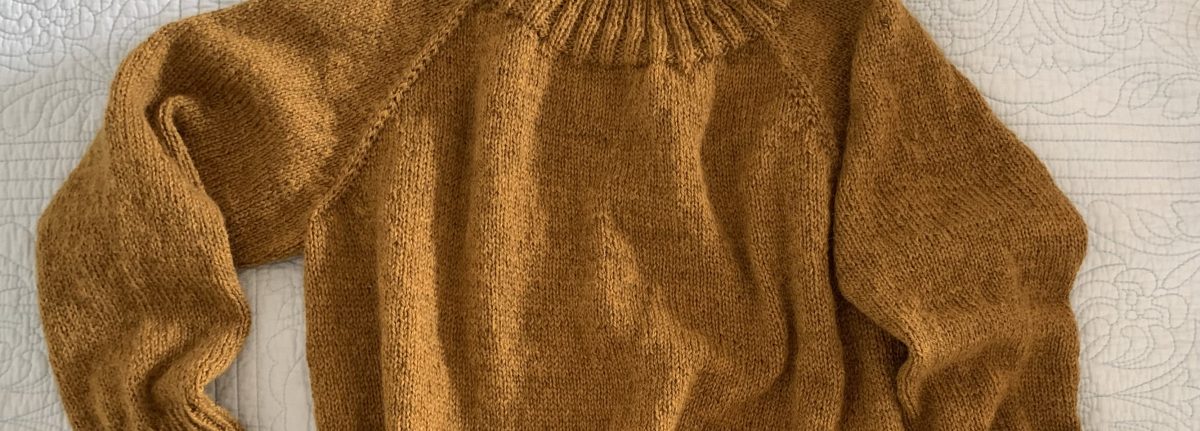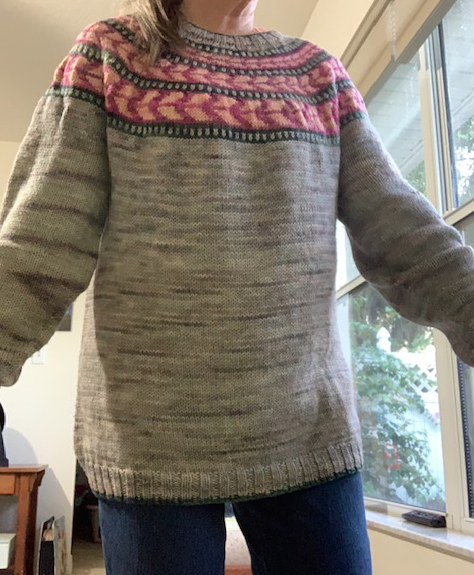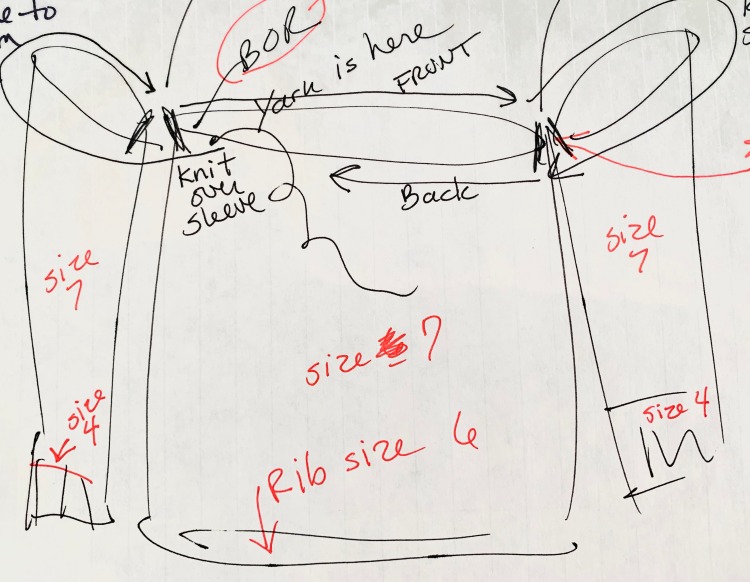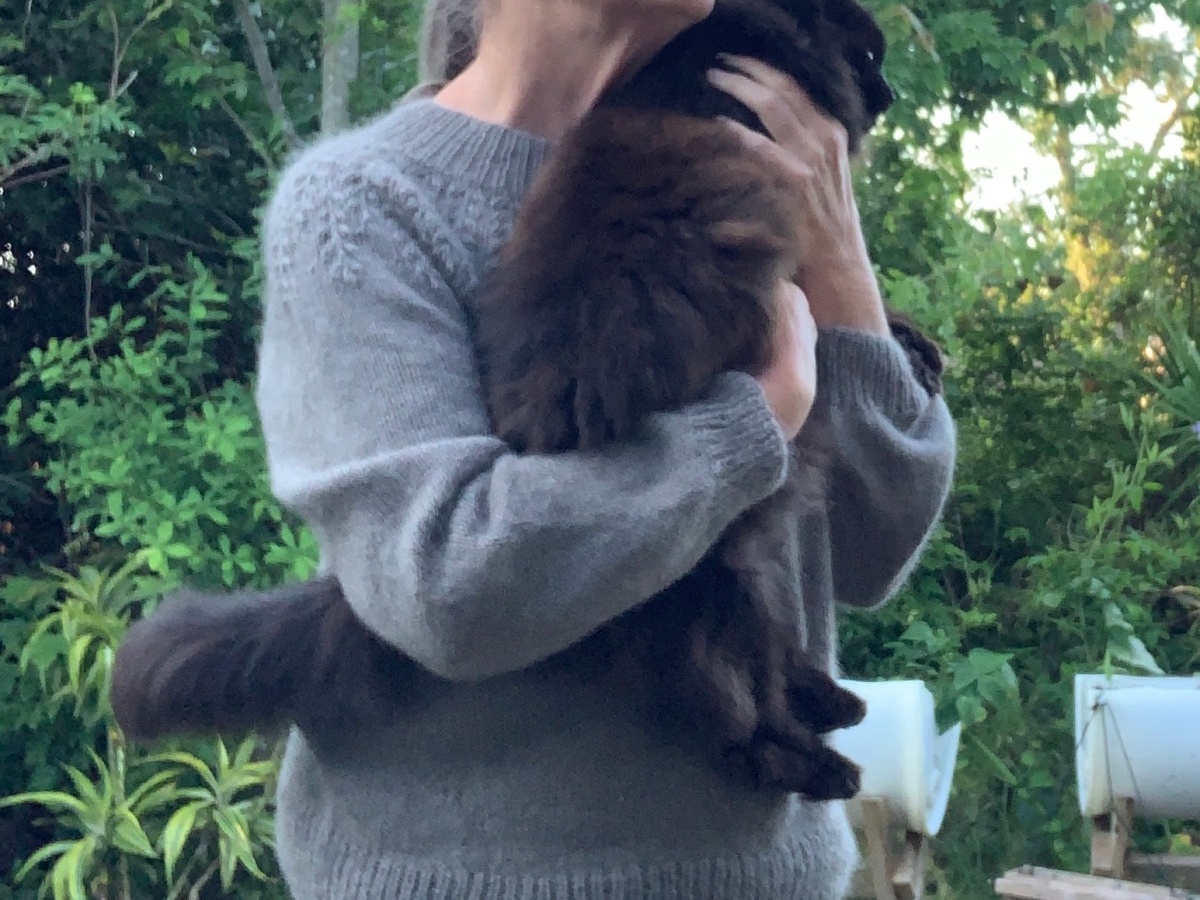After fiddling around with dishcloths, hats and scarves for a while, and getting basic stitches learned, I needed a bigger knitting project. I yearned to make a sweater just like all those pretty knitted sweaters I was seeing everywhere online.
I tried to find out as much information as I could before choosing the pattern. I read blogs, Ravelry pattern reviews, and visited the forums, but I still felt indecisive. What type should I choose? A top down, or bottom up? Cardigan or pullover? Plain or colorwork? I had done a bit of colorwork and liked it. A cardigan seemed like too much to handle with button bands, buttonholes and buttons! So, I chose a bottom-up pullover with some colorwork at the top by a designer I’d seen mentioned quite a bit, and bought the Umpqua sweater pattern by Caitlin Hunter.
Here’s a hint, you will figure out what you like best after you begin knitting sweaters! The trouble is, sweater knitting is expensive because of the amount of yarn needed. Also, often many different needles are required. Be ready to spend money. I knit a lot of sweaters I didn’t like to get to this point!
Learning From Beginner Mistakes
Here I am (below) wearing my Umpqua sweater. It has a lot of problems, because I really had no idea what I was doing.
First of all, the pullover is huge! The yarn I used was Superwash merino. Superwash yarn will stretch when washed, and that is what this sweater did. It was horrifying. I now knit with wool when sweater knitting, unless making something for a child or baby (which I have few reasons to do).
Second, there is an ugly pooling of colors on that sleeve. I had no idea at the time what “color pooling” was, but there it is. Hint: choose a solid color yarn. Even then, it’s a good idea to blend it when the skein is running low, but chances are it will look nice.
Third, the stranded colorwork on the yoke should have been knit in a larger needle so it would be smoother, and not pucker. Colorwork is generally tighter than plain old knitting.
It was fun to complete my first knitting project, but I decided to give the sweater away. I knew I would never wear it because it was so darn big! Live and learn.
The Expense of Sweater Knitting
I remember really wanting to knit a sweater. I did not have a clue as to the expense of doing so. The yarn is an obvious cost, and if you want a nice, cozy and comfy sweater made of non-acrylic yarn you will have to buy about 1,000+ yards of fairly expensive yarn.
If you have few to no knitting needles, you will need those too. Generally a sweater needs a circular needle large enough to hold all the body stitches. A size 32” length will usually work. Then there are the sleeves and neck. A 16” circular is needed for those, along with double-pointed needles (DPNs) for the small cuff circumference. Personally, I have some 9” circular needles to replace the DPNs.
If you have no needles, and need to find your gauge, buy only the long circular needle until you know if that size (not length, but needle size) will work for your project. If the pattern calls for a size 7 with a particular gauge but your gauge is too small or too large, another needle size is needed.
Sweater Knitting Terminology Explained
Good knitwear designers will describe their pattern before you even spend a penny. Whether the pattern is found on their website, or on their Ravelry page, the sweater sizes are listed (with yarn amounts needed), along with a description of how the sweater is knit. They give sizing, yarn types used, and often what special techniques will be used. From all that, the knitter will have an idea of amount of yarn needed – to figure price.
Knit Seamlessly – What does that mean?
Top-down sweaters are knit from the top down, and bottom-up sweaters, well – you guessed it. Often a designer will describe the sweater as “knit seamlessly from the top down / bottom up”. Seamlessly means the sweater is not knit in sections. There will be no side, or shoulder seams to sew together.
Sweaters that are not seamless will be knit flat in pieces that must be seamed together after the knitting is complete. Often sweaters with cables will be knit this way. For seamed sweaters, front and back pieces are knit flat (not in the round) and the pieces will need to be sewn together up the sides and at the shoulders. I’ve never knit a sweater like this.
Seamless sweaters are knit in the round (pullovers) or flat – back and forth (cardigans) and will have sleeve stitches that need to be put on hold because the body and sleeves are knit separately. You can’t get a way from that, unless your sweater is sleeveless!
Usually stitches are put on hold using a different yarn (called waste yarn). It should be thin, and not the color of your project. You will put all the sleeve stitches on hold with this yarn and have to pick up those stitches again later to knit the sleeves.
Examples of stitches “on hold”



Advantages of Knitting a Top-down Sweater
A top down sweater will begin at the neckline. The cast-on is done and the sweater expands out from there according to the pattern.
Usually, the back of neck shaping includes short rows, which you really want for comfort. Bottom up sweaters should also include this shaping and I highly suggest it. This raises the back so the front neck area won’t be high on the throat.
Gauging sweater length as you knit is the biggest advantage of top down. Most knitters will say that a top-down pullover allows for trying on as you go. Also easier to lengthen sleeves and body, or make changes to the bottom ribbing. I mostly knit top-down sweaters.
Anatomy of a Bottom-up Sweater
When a sweater is knit from the bottom up, often the body directions are given first. Some knitters suggest knitting a sleeve first and using it as a way to measure the gauge.
You need to know your gauge before beginning any sweater, and it needs to match the designers gauge as closely as possible. Swatching is not a waste of time!! Keep the swatch, with notes for yarn type and needle size, for future reference. I’m not getting into finding gauge here, but you must do it.
Once the body and two sleeves have been knit from the bottom up, everything is combined so the yoke and neck can be knit together. A sleeve is knit, then the front / back, next sleeve, and across to the BOR (beginning of round).
When it comes to attaching the sleeves to the body, sometimes drawing out a visual image helps me. Here is a drawing I did when it came time to attach sleeves and body on the Farfuglar sweater, which is knit bottom up. Does this make any sense to you?? LOL
Be Careful of These Things
After getting a number of sweater knits under my belt, I can tell you what I would avoid knitting. As a beginner, skip any pattern that includes some sort of lace or texture (see my failed Oxbow Cardigan). Use a simple knit and purl pattern. It can be boring, but there will be opportunity for expanding your horizons with short rows, make-one’s, and ribbing. Boring, one-color sweaters can end up being the best wardrobe staple!
If you have not done stranded colorwork knitting, avoid it in a sweater. Brioche is not something I can do even at this point, so I don’t recommend it for beginners.
If you are part of Ravelry, and read reviews of knitters, they will often say a pattern was “easy” and “quick” but take into consideration that those reviewers may have been knitting for 30 years longer than you have! Don’t believe all the reviews, and sweaters are never “quick”.
Know your yarn. In my humble opinion sweaters should be knit using wool. Isn’t a sweater for keeping warm? Use a pure, decent wool – worsted weight or fingering – they are out there. AND once the sweater is washed, it can change dramatically from scratchy to wonderful.
Sweater Patterns For Beginners
Now that I have knit a few sweaters of various styles, I’d like to share some favorites with you. One is baby size and is perfect for expanding knitting knowledge.
I’ve linked the sweaters to my blog pages where you can find notes and links that go to the pattern buying pages.





Clockwise above
- Top down cardigan – Cobblestone in blue. No button band to do (they are hard), it is knit right in. Good first cardigan pattern. Runs large. (Uses a worsted weight yarn.)
- Bottom up baby cardigan – Playdate by Tin Can Knits (fingering) Loved the uniqueness of this pattern, and because it’s small, a good practice piece.
- *The Calliope pullover is a free pattern from Espace Tricot. It has some texture around the neck, but is a straight-forward design. One of my favorite patterns.
- Top down cardigan (dark blue) – Fine Sand Pattern directions were a bit weird to figure out and lots of new (for me) types of increases were made around the top for shaping. I considered myself a beginner knitter at the time, and knit this just fine. There are no buttons or button bands to pick up.
- * Warm Up Sweater by Espace Tricot, is a free pattern and very easy to knit. It is a favorite pattern, and I wear the big comfy sweater (knit with Lettlopi wool – thicker yarn, quicker knit) all through our cooler Florida winter mornings.










